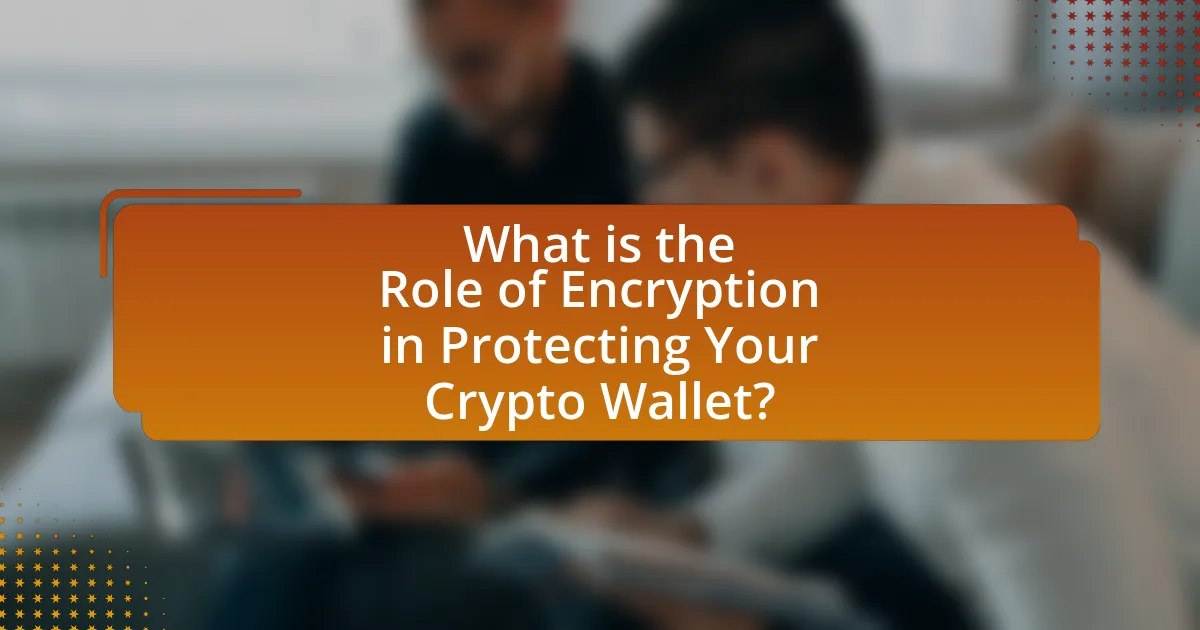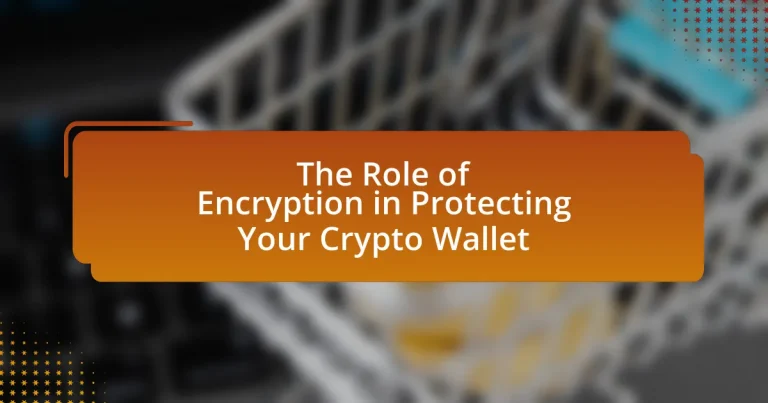Encryption is a critical component in safeguarding crypto wallets, as it protects sensitive information and transactions from unauthorized access. The article explores how encryption enhances wallet security through various methods, including symmetric and asymmetric encryption, and hashing algorithms. It highlights the risks associated with unencrypted wallets, the importance of strong encryption practices, and the implementation of additional security measures like multi-factor authentication. Furthermore, it addresses common misconceptions about encryption and provides best practices for users to effectively secure their crypto assets.

What is the Role of Encryption in Protecting Your Crypto Wallet?
Encryption plays a crucial role in protecting your crypto wallet by securing sensitive information and transactions from unauthorized access. It ensures that private keys, which are essential for accessing and managing cryptocurrencies, are encoded in a way that only authorized users can decrypt and use them. For instance, strong encryption algorithms like AES (Advanced Encryption Standard) are commonly employed to safeguard wallet data, making it nearly impossible for hackers to decipher without the correct decryption key. This level of security is vital, as breaches can lead to significant financial losses, with reports indicating that over $1.9 billion in cryptocurrency was stolen in 2020 alone due to inadequate security measures. Thus, encryption is fundamental in maintaining the integrity and confidentiality of crypto wallets.
How does encryption enhance the security of crypto wallets?
Encryption enhances the security of crypto wallets by converting sensitive data into a coded format that is unreadable without a decryption key. This process protects private keys and transaction information from unauthorized access, ensuring that only the wallet owner can access their funds. For instance, strong encryption algorithms like AES (Advanced Encryption Standard) are widely used in crypto wallets, making it extremely difficult for hackers to decipher the data without the correct key. Additionally, encryption helps to maintain the integrity of transactions by preventing tampering, as any alteration in the encrypted data would render it invalid.
What types of encryption are commonly used in crypto wallets?
Common types of encryption used in crypto wallets include symmetric encryption, asymmetric encryption, and hashing. Symmetric encryption, such as AES (Advanced Encryption Standard), uses the same key for both encryption and decryption, providing a secure method for protecting private keys. Asymmetric encryption, exemplified by RSA (Rivest-Shamir-Adleman), employs a pair of keys—public and private—for secure transactions and communications. Hashing algorithms like SHA-256 (Secure Hash Algorithm 256-bit) are utilized to create a fixed-size output from variable input data, ensuring data integrity and security by making it nearly impossible to reverse-engineer the original data. These encryption methods are essential for safeguarding sensitive information in crypto wallets, as they help prevent unauthorized access and ensure the confidentiality and integrity of users’ assets.
How does encryption prevent unauthorized access to crypto wallets?
Encryption prevents unauthorized access to crypto wallets by converting sensitive data into a coded format that can only be deciphered with a specific key or password. This process ensures that even if an unauthorized party gains access to the wallet’s data, they cannot interpret it without the decryption key. For instance, strong encryption algorithms like AES (Advanced Encryption Standard) are widely used in crypto wallets, making it computationally infeasible for attackers to break the encryption without the correct key. This level of security is crucial, as it protects users’ private keys and transaction information from theft and fraud.
Why is encryption crucial for cryptocurrency security?
Encryption is crucial for cryptocurrency security because it protects sensitive data from unauthorized access and ensures the integrity of transactions. By using cryptographic algorithms, encryption secures private keys and transaction details, making it nearly impossible for hackers to intercept or alter information. For instance, the use of public-key cryptography allows users to generate a unique pair of keys, where the public key is shared openly while the private key remains confidential. This method has been foundational in securing blockchain networks, as evidenced by Bitcoin’s implementation of SHA-256 hashing, which enhances security by making it computationally infeasible to reverse-engineer the original data from the hash. Thus, encryption serves as a fundamental barrier against fraud and theft in the cryptocurrency ecosystem.
What risks do crypto wallets face without encryption?
Crypto wallets without encryption face significant risks, including unauthorized access, theft of funds, and data breaches. Without encryption, sensitive information such as private keys and transaction details can be easily intercepted by malicious actors. For instance, a study by the Cybersecurity and Infrastructure Security Agency (CISA) highlighted that unencrypted wallets are vulnerable to hacking, leading to potential financial losses for users. Additionally, without encryption, users’ personal data can be exposed, increasing the likelihood of identity theft. These risks underscore the critical importance of encryption in safeguarding crypto wallets.
How does encryption mitigate the impact of cyber threats?
Encryption mitigates the impact of cyber threats by transforming sensitive data into a format that is unreadable without a decryption key. This process protects information from unauthorized access, ensuring that even if data is intercepted during transmission or storage, it remains secure. For instance, the use of Advanced Encryption Standard (AES) has been widely adopted, providing a robust level of security that is difficult for attackers to breach. According to the National Institute of Standards and Technology (NIST), AES encryption is considered secure against brute-force attacks, making it a reliable method for safeguarding digital assets, including those in crypto wallets.
What are the key features of encryption in crypto wallets?
The key features of encryption in crypto wallets include data protection, secure key management, and transaction integrity. Data protection ensures that sensitive information, such as private keys and transaction details, is stored in an encrypted format, making it inaccessible to unauthorized users. Secure key management involves the generation and storage of cryptographic keys in a way that prevents exposure, often utilizing techniques like hierarchical deterministic wallets. Transaction integrity is maintained through cryptographic signatures, which verify the authenticity of transactions and prevent tampering. These features collectively enhance the security of crypto wallets, safeguarding users’ assets against theft and fraud.
How does end-to-end encryption work in the context of crypto wallets?
End-to-end encryption in the context of crypto wallets ensures that only the wallet owner can access their private keys and transaction data. This process involves encrypting the data on the user’s device before it is transmitted over the internet, meaning that even if the data is intercepted, it remains unreadable without the decryption key, which is only stored on the user’s device. For instance, when a user initiates a transaction, their wallet software encrypts the transaction details using a cryptographic algorithm, and only the recipient’s wallet can decrypt this information using the corresponding key. This method protects against unauthorized access and potential hacks, as the data remains secure throughout its journey from sender to receiver.
What role does public and private key encryption play in wallet security?
Public and private key encryption is fundamental to wallet security as it ensures that only the rightful owner can access and manage their cryptocurrency. In this system, the public key serves as an address for receiving funds, while the private key is a secret that allows the owner to sign transactions and prove ownership. This asymmetric encryption model protects wallets from unauthorized access, as the private key is never shared and is required to authorize any transaction. The security of this method is reinforced by the mathematical complexity of deriving the private key from the public key, making it virtually impossible for attackers to gain access without the private key.
How can users implement encryption for their crypto wallets?
Users can implement encryption for their crypto wallets by utilizing strong encryption algorithms to secure their private keys and wallet data. This can be achieved through software wallets that offer built-in encryption features, such as AES (Advanced Encryption Standard), which is widely recognized for its security and efficiency. Additionally, users should enable two-factor authentication (2FA) and use hardware wallets that provide an extra layer of security by storing private keys offline, thus minimizing the risk of unauthorized access. According to a report by the European Union Agency for Cybersecurity, employing encryption significantly reduces the likelihood of data breaches, reinforcing the importance of these practices in safeguarding crypto assets.
What steps should users take to encrypt their wallets effectively?
To encrypt their wallets effectively, users should follow these steps: first, choose a reputable wallet that offers built-in encryption features, such as hardware wallets or software wallets with strong security protocols. Next, users must create a strong, unique password that combines letters, numbers, and symbols to enhance security. Additionally, enabling two-factor authentication (2FA) provides an extra layer of protection against unauthorized access. Users should also regularly update their wallet software to ensure they have the latest security patches. Finally, backing up the wallet’s encryption keys in a secure location, such as a password manager or a physical safe, is crucial to prevent loss of access. These steps are validated by cybersecurity best practices, which emphasize the importance of strong passwords and multi-factor authentication in safeguarding digital assets.
What tools and software are available for wallet encryption?
Various tools and software are available for wallet encryption, including hardware wallets, software wallets, and encryption tools. Hardware wallets like Ledger and Trezor provide secure offline storage and encryption for cryptocurrencies. Software wallets such as Exodus and Electrum offer built-in encryption features to protect private keys. Additionally, encryption tools like VeraCrypt can be used to create encrypted containers for storing wallet files securely. These options ensure that users can safeguard their crypto assets against unauthorized access and theft.
What are the common misconceptions about encryption in crypto wallets?
Common misconceptions about encryption in crypto wallets include the belief that encryption alone guarantees complete security and that all wallets use the same level of encryption. Many users assume that once their wallet is encrypted, it is immune to hacking or theft, which is incorrect; encryption protects data but does not prevent all forms of attack, such as phishing or malware. Additionally, not all crypto wallets implement encryption uniformly; some may use outdated algorithms or weak encryption methods, making them vulnerable. According to a report by the European Union Agency for Cybersecurity, the effectiveness of encryption depends on the strength of the algorithms used and the security practices of the wallet provider.
Why do some users underestimate the importance of encryption?
Some users underestimate the importance of encryption because they lack awareness of the potential risks associated with unprotected data. Many individuals believe that their information is not valuable enough to warrant encryption, leading to complacency. For instance, a 2021 report by Cybersecurity Ventures projected that cybercrime damages would reach $6 trillion annually, highlighting the significant threat posed to unencrypted data. This lack of understanding about the severity of cyber threats contributes to the underestimation of encryption’s role in safeguarding sensitive information, particularly in the context of protecting crypto wallets.
How can misinformation about encryption lead to security vulnerabilities?
Misinformation about encryption can lead to security vulnerabilities by causing users to misunderstand its effectiveness and implementation. For instance, if individuals believe that encryption alone guarantees complete security, they may neglect other critical security measures, such as strong passwords or two-factor authentication. This misconception can result in increased susceptibility to attacks, as attackers may exploit these gaps in security. A study by the Ponemon Institute found that 60% of organizations experienced a data breach due to human error, often stemming from misunderstandings about security protocols, including encryption. Thus, accurate information about encryption is essential to ensure comprehensive security practices are adopted.
What best practices should users follow for encrypting their crypto wallets?
Users should follow several best practices for encrypting their crypto wallets to enhance security. First, they should use strong, unique passwords that combine letters, numbers, and special characters, as weak passwords can be easily compromised. Additionally, enabling two-factor authentication (2FA) adds an extra layer of protection, making unauthorized access significantly more difficult.
Regularly updating wallet software is crucial, as updates often include security patches that protect against vulnerabilities. Users should also consider using hardware wallets, which store private keys offline, reducing the risk of online attacks. Furthermore, backing up wallet data securely ensures that users can recover their assets in case of loss or theft.
Finally, users should be cautious about phishing attempts and only download wallet software from reputable sources, as malicious software can compromise wallet security. These practices collectively help safeguard crypto wallets against unauthorized access and potential loss.
How often should users update their encryption methods?
Users should update their encryption methods at least annually or whenever there is a significant change in their security environment. Regular updates are essential because encryption standards evolve, and vulnerabilities can be discovered over time. For instance, the National Institute of Standards and Technology (NIST) recommends reviewing cryptographic algorithms and keys regularly to ensure they meet current security standards. Additionally, if a data breach occurs or if new vulnerabilities are identified, immediate updates to encryption methods are necessary to maintain security.
What additional security measures complement encryption in protecting crypto wallets?
Multi-factor authentication (MFA) is a crucial additional security measure that complements encryption in protecting crypto wallets. MFA requires users to provide two or more verification factors to gain access, significantly reducing the risk of unauthorized access. For instance, even if an attacker obtains the wallet’s encryption key, they would still need the second factor, such as a one-time code sent to the user’s mobile device, to access the wallet. This layered approach enhances security, as studies show that MFA can block up to 99.9% of automated attacks, according to a report by Microsoft. Other complementary measures include using hardware wallets, which store private keys offline, and regularly updating software to patch vulnerabilities, further fortifying the security of crypto wallets.


